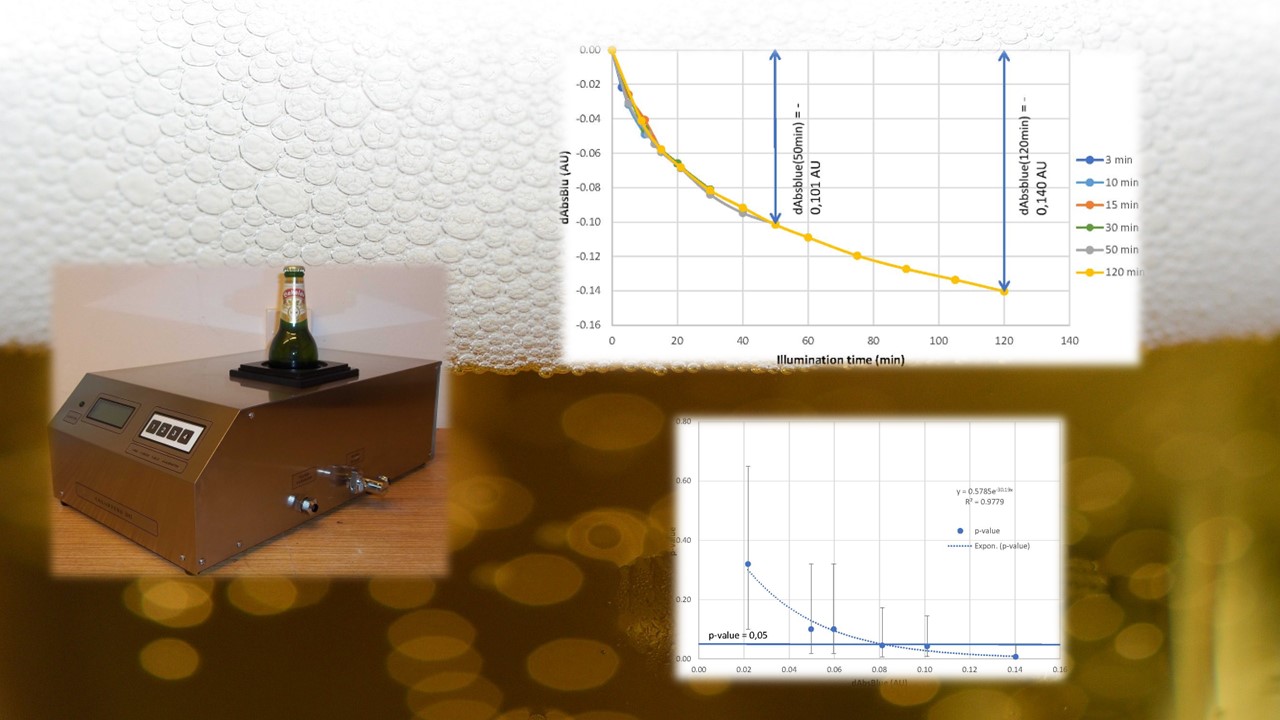Beer Photodegradation in Commercial Bottles: Simultaneous Evaluation by Consumer Sensory Panels and Optical Detection
Keywords:
beer, photodegradation, light-struck flavour, riboflavin, absorbance, laic sensory panel, triangle sensory test, HPLC analysis, functional data, regressionAbstract
The impact of light on beer degradation is a well-established phenomenon, leading to development of undesirable flavours or, in severe cases, complete spoilage. This study investigates the extent to which photodegradation is perceptible to beer consumers. Beer samples in commercial bottles were subjected to controlled light exposure to induce defined levels of degradation. The degree of light damage was monitored using both an optical method of tracking changes in absorbance and riboflavin content via HPLC and a sensory evaluation by a lay consumer sensory panel. The findings from the sensory panel were statistically compared with the optical measurement results, highlighting correlations between the sensory perception and quantifiable optical changes.
References
Anděl, J. (1998). Statistické metody. Matfyzpress, Praha, Česká republika. ISBN 80-85864-27-8
Čejka, P., Olšovská, J. (2015). Use of Sensory Analysis in Marketing. Kvasny Prumysl, 61(2), 38–45. https://doi.org/10.18832/kp2015006
Gabriel, P., Dienstbier, M., Fous, K., Matoulková, D. (2022a). Characterization of packaging ability to protect beer from light degradation and introduction of a new Packaging Riboflavin Index. Kvasny Prumysl, 68(5), 679–685, https://doi.org/10.18832/kp2022.68.679
Gabriel, P., Škoda, J., Benešová, K., Matoulková, D. (2022b). Direct detection of beer photodegradation in commercial bottles and introduction of a new Lightstruck Flavor Susceptibility Index. Kvasny Prumysl, 68(6), 656–662. https://doi.org/10.18832/kp2022.68.656
Gabriel, P., Sigler, K. (2018). A device monitoring the turbidity and color changes of beverages directly in bottled samples. Kvasny Prumysl, 64(5), 224–232. https://doi.org/10.18832/kp201831
Hucker, B., Wakeling, L., Vriesekoop, F. (2011). The quantitative analysis of thiamin and riboflavin and their respective vitamers in fermented alcoholic beverages. Journal of Agricultural and Food Chemistry, 59(23), 12278–12285. https://doi.org/10.1021/jf202647x
International Standard ISO 4120:2021. Sensory analysis — Methodology — Triangle test. ISO, Geneve.
Irwin, A.J., Bordeleau, L., Barker, R.L. (1993). Model Studies and Flavor Threshold Determination of 3-Methyl-2-Butene-1-Thiol in Beer. Journal of the American Society of Brewing Chemists, 51(1), 1–3. https://doi.org/10.1094/ASBCJ-51-0001
Lawless, H.T., Heymann, H. (2010). Sensory evaluation of food. Springer, New York, USA. ISBN 978-1-4419-6487-5, https://doi.org/10.1007/978-1-4419-6488-5
Lintner, C. (1875). Lehrbuch der Bierbrauerei. Verlag Vieweg und Sohn, Braunschweig, Germany, p. 343.
O’Mahony, M. (1986). Sensory Evaluation of Food (1st Edition). CRC Taylor&Francis, Boca Raton, USA. eISBN 9780203739884, https://doi.org/10.1201/9780203739884
Pozdrik, R., Roddick, F., Rogers, P., Nguyen, T. (2006). Spectrophotometric method for exploring 3-methyl-2-butene-1-thiol (MBT) formation in lager. Journal of Agricultural and Food Chemistry, 54(17), 6123–6129. https://doi.org/10.1021/jf060515v
Sakuma, S., Rikimaru, Y., Kobayashi, K., Kowaka, M. (1991). Sunstruck flavor formation in beer. Journal of the American Society of Brewing Chemists, 49(4), 162–165. https://doi.org/10.1094/ASBCJ-49-0162
Templar, J., Arrigan, K., Simpson, W.J. (1995). Formation, measurement and significance of lightstruck flavor in beer: A review. Brewers Digest, 70, 18–25.
Wasserstein, R.L., Lazar, N.A. (2016). The ASA's Statement on p-Values: Context, Process, and Purpose. The American Statistician, 70(2), 129–133. https://doi.org/10.1080/00031305.2016.1154108

Published
How to Cite
Issue
Section
License
Copyright (c) 2024 Roman Králik, Petr Gabriel, Martin Dušek, Jaromír Antoch

This work is licensed under a Creative Commons Attribution 4.0 International License.







